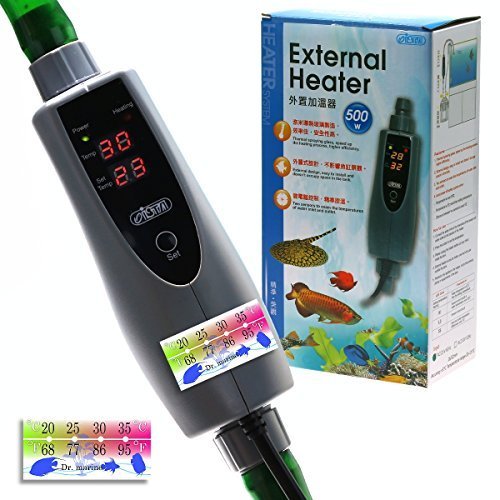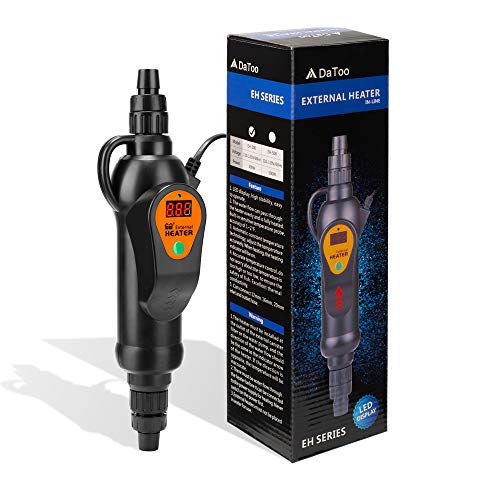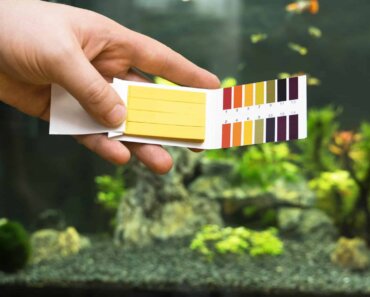If you’re limited on space or if you just want a clean design for your fish tank setup, then an inline aquarium heater will help keep some equipment out of the display. While these heaters are currently used by many hobbyists, their popularity has not fully caught on in the aquarium trade just yet. Because of this, not many brands have inline aquarium heaters available even though there are many pros to using them in your own fish tank.
Luckily, we’re picked out the best 3 inline aquarium heaters currently available based on reliability, precision and accuracy, customer reviews, and price.
What is an aquarium heater?
Aquarium heaters might be the most important piece of equipment that you can get for your fish tank. Unfortunately, many times they can be unreliable, and too many times hobbyists come home or wake up to an overheating tank. Because of this, it’s critical to start with a reliable and durable heater from the very start of your aquarium so that you don’t risk the chance of something going wrong and avoid having to buy an entirely new one farther down the line.
But why do you need an aquarium heater and how do you pick the one that’s best for your fish tank setup?
What do aquarium heaters do?
In general, there are three different kinds of aquarium heaters available: substrate heaters, submersible heaters, and inline heaters. Each one of these will safely and accurately heat up your fish tank water to the desired temperature by way of a thermostat, sensors, and other detectors.
Why do you need an aquarium heater?
Most of the freshwater and saltwater fish kept in the aquarium hobby come from the tropical waters of South America where the water stays in a relatively small temperature range. These fish rely on temperature to perform necessary metabolic and other physiological processes; plants, corals, and invertebrates equally rely on a stable temperature to thrive.
Most hobbyists live outside of a steady climate and experience four seasons where sometimes, the temperature changes drastically between the days and nights. An aquarium heater not only warms the water but keeps the temperature from fluctuating too much, which can easily send fish, invertebrates, and corals into shock. Some hobbyists even use a heater when keeping coldwater species, like goldfish, in order to lessen the impact of these small daily fluctuations in temperature.
Two other important uses of an aquarium heater are for treating disease and for breeding fish. In order to treat most parasites, infections, and diseases, it is recommended to heat the fish tank to slightly above average to inhibit the reproduction of common parasites, like ich or white spot disease (Ichthyophthirius multifiliis).
Most fish also rely on the changing seasons to breed, which can be replicated with an aquarium heater as well; with most aquarium species, fish will spawn when temperatures rise. This can be induced with small incremental temperature changes with the aquarium heater.
What is an inline aquarium heater?
Inline aquarium heaters are external heating devices that warm water as it is being passed through the tubing; this heater sits outside of the aquarium, freeing up space in the actual fish tank display.
These heaters are usually bulkier than typical submersible heaters typically found in home aquariums and might have a digital display, an indicator light, and/or a button or analog dial to control temperature settings.
How do inline aquarium heaters work?
Most often, an inline aquarium heater is installed in the output tubing that leads from a sump or canister filter back into the main aquarium. An inline aquarium heater will only turn on when the water temperature has fluctuated enough from the desired value and will only serve as a tubing connector otherwise.
Are inline heaters better than submersible heaters?
In short, every fish tank is different and one thing that works for one system might completely destroy another system. It’s important to consider the pros and cons of both inline heaters and submersible heaters to see which one best fits your freshwater or saltwater fish tank setup for the long run.
Pros of using an inline aquarium heater
There are a few benefits to using an inline heater in your fish tank, like being hidden from view, getting an accurate and precise temperature, and making water changes easier.
Space
For some hobbyists, aesthetic is everything in their aquariums; entire aquascapes are built around hiding equipment as much as possible while still getting full functionality. If planning on keeping more aggressive fish species, then it’s usually best to keep as many wires and cords out of the tank as possible as well!
Some hobbyists are just pressed for space in their aquariums and need to keep equipment out of the tank to ensure that their fish actually have room to swim around. Whatever the reason might be, an inline heater will free up space in the aquarium, and give more freedom to other equipment and decoration placement within the tank.
Accuracy and precision
Submersible heaters need to be placed in an area of higher flow so that the thermostat doesn’t receive false readings due to uneven temperature spots in the tank. This means that you need to plan the location of your heater so that water is constantly being cycled past the device which can be difficult to correctly place in especially larger aquariums. This can also cause an inaccurate reading from your aquarium thermometer.
Inline aquarium heaters eliminate this problem entirely. The water is warmed on its way back to the tank from the canister filter or sump and then dispersed through the tank by way of the output nozzle and/or other powerheads, creating an even spread of temperature. For larger aquariums, this can help prevent cold or hot pockets from happening in the tank due to lack of water flow.
Easier water changes
Inline aquarium heaters make water changes in your fish tank easier in a few ways. One, you will not have to worry about unplugging your submersible aquarium heater due to water levels getting too low. At the same time, you will not have to worry about accidentally hitting the heater or causing decorations to fall onto it that could potentially break or shatter the device.
When performing a water change with an inline heater, you are safe from potentially breaking your heater, disrupting the programmed settings, and having to plug and unplug the device!
Cons of using an inline aquarium heater
However, there are a few reasons why inline heaters haven’t become popular in the aquarium hobby just yet. It should be noted that most fish tank heater products have the tendency of overheating and is not exclusive to just external heaters.
Prone to leakage
Sadly, external heaters usually get a bad name because of their horrible tendency to leak. This might be the result of improper installation, poor product design, or a mixture of both.
Because these heaters have not caught on just yet, many aquarium brands have not tried to produce inline heaters and if they have, they have made little advances to improving them. However, if done right, an inline aquarium heater should be as trusty as any other external plumbing that might be on your tank.
More expensive
For the same reasons of low demand, inline aquarium heater products tend to be more expensive than submersible heaters. This is most likely due to the demand for these heater products being low and the technology being slightly more advanced and/or still in trial.
The best inline aquarium heaters
If you’ve decided that an inline aquarium heater is best for your tank, then luckily, you won’t have too many options to choose from.
It’s important to consider the reliability, precision and accuracy, customer reviews, and price when choosing between external heaters as a heater is often one of the most important pieces of equipment in home aquariums!
Hydor In-Line External Heater – Original ETH
The Hydor In-Line External Heater – Original ETH is probably the best known inline aquarium heater. These heaters are optimal for sumps or canister filters and will heat water as it is returned to the main aquarium display with precision. The Hydor In-Line External Heater runs on PTC technology (Positive Thermal Coefficient) to best prevent the device from malfunctioning and overheating.
This Hydor inline aquarium heater comes in several different options including, 200 watts 1/2″, 200 watts 5/8″, and 300 watts 5/8″. The wattage relates to the power of the heater, with 200 watts being recommended for aquarium setups up to 50 gallons (189.3 L) and 300 watts being sized for systems over 50 gallons but under 80 gallons (302.8 L). The face of this heater has a manual temperature control dial and an indicator light for when the heating element is engaged.
This heater needs to be held in a vertical position for the best heating results; some reviews have found initial leakage, though tight seals and proper installation should prevent any major occurrences. Customer reviews have also found that this aquarium heater makes clicking noises from time to time, but does not affect the overall heating functionality or water flow of the device.
What we like:
- Easy-to-use heater and minimal design
- Works best for sump tank and canister filter setups
- Good water flow and does not easily clog
What could be better:
- Lacks important plumbing parts for a tight seal
- The spin dial can be difficult to read
- Does not operate correctly if not fully vertical
- More expensive than a traditional submersible aquarium heater
150w/300w/500w in-Line External Heater Aquarium Heater – 150/300/500 WATT 1/2″-5/8″
- The ISTA in-line external heater is designed for vertical use in most aquarium applications involving water hose of the specified diameter.
- The ISTA External Heater must be used in a vertical manner for correct operation. The most common application is for use with canister filter, however the ISTA External Heater is easily adapted for…
- The ISTA External Heater is easily installed by cutting the tubing and connecting the two parts of the tube to each side of the ISTA External Heater.For reduced maintenance, it is recommended that the…
The 150w/300w/500w in-Line External Heater Aquarium Heater from ISTA is a comparable alternative to the Hydor heater but offers a more high-tech interface. This inline aquarium heater features a digital interface that indicates if power is being received, if the heating element is on or off, the current water temperature, and the set temperature; these temperature settings are displayed in degrees Celsius (°C) only.
This heater comes in four size options: 150 watts 5/8″ (16/22mm) Hose, 300 watts 1/2″(12/16mm) Hose, 300 watts 5/8″ (16/22mm) Hose, and 500 watts 5/8″ (16/22mm) Hose. The current tank water temperature is processed with two thermostat sensors for precise temperature readings and exact heating precision. This heater is also designed with thermal spraying glass for quicker warming.
Hobbyists have found that this external heater is a little larger than most competitors, especially once various adapters have been fitted. Like other inline heaters, it has a tendency to leak and can become clogged over time. It also takes some getting-used-to converting Celsius to Fahrenheit if unfamiliar with the measurement of degrees.
What we like:
- Several power and size options for an exact fit to tank and plumbing
- Two temperature sensors for high precision reading
- Thermal spraying glass increases the efficacy of the heater and lowers the heating time
What could be better:
- Can be bulky when used with certain adapters
- Has a tendency to leak and clog easily
- Can be initially uncomfortable to convert Celsius to Fahrenheit
DaToo Aquarium External Heater In-Line Fish Tank External Heater 300W for Canister Filter
- Perfect Aquarium External Heater For Your Needs: For every hobbyist or professional fish breeder with a canister filter, a perfect external heater is essential. DaToo Aquarium External Heater is…
- Leading Temperature Control System: For the health of fish, a precise and constant temperature is very important. DaToo Heater’s temperature control system uses advanced STM8 chip, which ensures that…
- Safe Over-Heat Protection: DaToo Aquarium External Heater has two temperature sensors, one at the heater inlet and the other at the outlet. This makes DaToo heater can be more accurate to measure…
The DaToo Aquarium External Heater In-Line Fish Tank External Heater is a particularly good choice of inline heater if you already have a Sunsun fish tank product. The DaToo glass-ceramic heater works best with canister filters but comes with three adapters for 1/2 inch (12 mm), 5/8 inch (16 mm), and 20 mm hoses for more versatile use.
This aquarium heater has a digital LED interface for easy temperature readings as well as a heating indicator and adjustment button. The technology is based around an STM8 chip, which provides high precision between 68-95° F (20-35° C); two temperature thermostat sensors ensure extra security, shutting down heating once the temperature fluctuates 0.2° F from the desired value. A cleaning brush is also included to help keep the heater working properly and a one-year warranty is guaranteed.
Customer reviews have found that despite the advertised thermostat accuracy, water temperature tends to fluctuate and can easily overheat or underheat the aquarium. If the tank temperature is higher than the desired value, then the interface will give an error reading, which can be initially confusing. However, many hobbyists appreciate the multiple adaptors for easy fish tank installation.
What we like:
- Easy-to-use and simple temperature control interface
- Multiple adaptors for universal installation
- Included cleaning brush and one year warranty
- Designed with Sunsun aquarium products in mind
- Less expensive than competitors
What could be better:
- Has a tendency to fluctuate and/or overheat or underheat
- Initially difficult to program
- Bulky design
Conclusion
The inline heater may not be the most popular choice when choosing a heater for your fish tank, but it’s definitely an option to consider if using sumps or canister filters. There are a few things to consider when picking the best inline heater for your aquarium, like reliability, size, and if it will keep a precise temperature to keep your fish and tank inhabitants the happiest they can be.
Always make sure to read the directions fully to prevent any leaks; additional plumbing might be needed in order to keep an extra tight seal.
If you have any questions about inline heaters or another type of aquarium heater, don’t hesitate to leave a comment below!
- https://www.amazon.com/Hydor-Line-External-Aquarium-Heater/dp/B0002Z7VQE/ref=sr_1_2?dchild=1&keywords=hydor%2Bin-line%2Baquarium%2Bheater&qid=1608146328&sr=8-2&th=1
- https://www.amazon.com/Line-External-Heater-AQUARIUM-HEATER/dp/B01M9J12EI/ref=sr_1_1?dchild=1&keywords=150w%2F300w%2F500w%2Bin-Line%2BExternal%2BHeater%2BAquarium%2BHeater%2B-%2B150%2F300%2F500%2BWATT%2B1%2F2%22-5%2F8%22&qid=1608154506&s=pet-supplies&sr=1-1&th=1
- https://www.amazon.com/DaToo-Aquarium-External-Heater-Canister/dp/B07YX682W4/ref=sr_1_1?dchild=1&keywords=DaToo+Aquarium+External+Heater+In-Line+Fish+Tank+External+Heater+300W+for+Canister+Filter&qid=1608319267&s=pet-supplies&sr=1-1




























